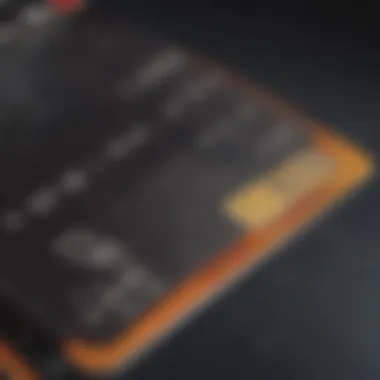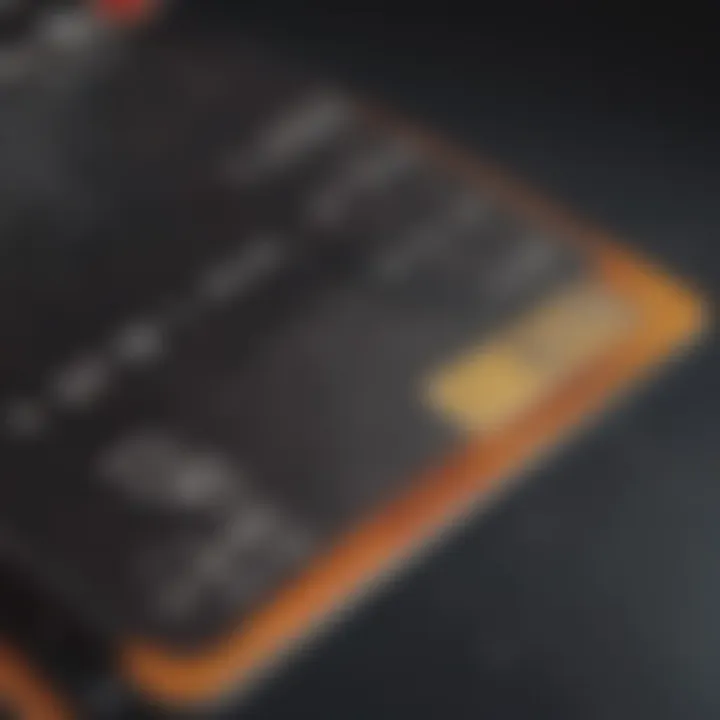Evaluating the Efficacy of Credit Cards: A Detailed Review


Intro
Credit cards have become integral in personal finance, offering convenience and flexibility for managing expenses. Understanding the efficacy of these financial tools is essential for individuals looking to navigate modern monetary systems effectively. Credit cards offer various features that can benefit users but also come with potential risks. The essence of this analysis is to dissect these aspects, enabling readers to make informed choices aligned to their financial circumstances.
Overview of Financial Product
Definition
A credit card is a payment card issued by a financial institution that allows cardholders to borrow funds up to a predetermined limit to pay for goods and services. Users are required to repay the borrowed amount at the end of each month, typically with interest if the total balance is not settled.
Key Features
Credit cards come with several noteworthy features:
- Credit Limit: The maximum amount a cardholder can borrow on the card.
- Grace Period: The time frame during which no interest is charged if the total balance is paid by the due date.
- Rewards and Benefits: Many cards offer incentives such as cash back, points, or travel rewards.
- Additional Protections: Some cards include purchase protections, extended warranties, or rental car insurance.
Purpose and Benefits
The primary purposes of credit cards include:
- Short-term Financing: Helping users manage their spending until their income is received.
- Building Credit History: Responsible use of a credit card can enhance a person's credit score.
- Emergency Access to Funds: Credit cards can serve as a safety net in unforeseen financial situations.
Types and Categories
Credit Card Types
There are several types of credit cards catering to different needs:
- Standard Credit Cards: Basic cards with no frills, often with lower fees.
- Rewards Credit Cards: Cards that offer points, miles, or cash back on purchases.
- Secured Credit Cards: Designed for individuals with poor or no credit history, backed by a cash deposit.
- Business Credit Cards: Tailored for business expenses, often offering higher limits and more rewards.
Pros and Cons
Understanding the advantages and disadvantages is crucial:
- Pros:
- Cons:
- Convenience in transactions
- Ability to earn rewards
- Enhanced security features
- High interest rates if balance is carried
- Potential for overspending
- Fees if payments are missed or late
Situational Uses
Credit cards may serve varied situations:
- Travel Purchases: Using travel rewards cards can yield better benefits.
- Emergency Expenses: Quickly covering unforeseen medical or home repairs.
- Everyday Expenses: Earning rewards on regular purchases but with caution to avoid debt.
Application Process
Steps to Apply
The process of applying for a credit card generally includes:
- Researching Options: Finding the right card that fits your needs.
- Completing an Application: Filling out necessary information online or in person.
- Receiving Approval: Once approved, the card will be sent via mail.
Eligibility Requirements
Issuers typically look for:
- A satisfactory credit score.
- Stable income.
- A history of responsible financial behavior.
Documentation Needed
Commonly needed documents include:
- Proof of identity (e.g. driver's license).
- Proof of income (e.g. pay stubs).
- Social Security number for verification.
Common Mistakes to Avoid
When applying, keep in mind:
- Not reading the fine print about fees.
- Applying for too many cards at once, which can hurt your credit.
- Rushing the decision without fully researching.
Tips for Success
To enhance the application experience:
- Check your credit score before applying.
- Compare different cards for better terms.
- Use a financial calculator to understand potential costs.
Costs and Fees


Types of Fees Associated
Credit cards can have various fees:
- Annual Fees: Charged yearly for card usage.
- Late Payment Fees: If payment is received after the due date.
- Foreign Transaction Fees: Charged for purchases made in different currencies.
Interest Rates and APR for Loans/Cards
Interest rates vary widely and are often influenced by credit scores. Understanding the Annual Percentage Rate (APR) is key, as it reflects the total yearly cost of interest.
Comparisons of Costs Across Options
Comparing costs across credit card options can help identify the most beneficial choice. Factors to consider include interest rates, fees, and rewards programs.
In evaluating credit cards, it is crucial to discern the balance between rewards and costs, enabling informed financial decisions.
By understanding the overall mechanics of credit cards, individuals gain a comprehensive view of how to utilize them effectively. This ensures a alignment with personal financial goals while mitigating potential risks.
Preface to Credit Cards
Credit cards are an essential tool in modern financial management. They offer flexibility, convenience, and a way to build credit history. Understanding their importance is crucial for making informed financial decisions. This section brings focus on what credit cards are and how they have evolved over time. It gives context to the pros and cons discussed later in the article.
Definition and Functionality
Credit cards are financial instruments that allow individuals to borrow funds from a lending institution up to a predetermined limit. The cardholder can make purchases or withdraw cash, agreeing to pay back the borrowed amount, usually with interest. This system operates on the principle of revolving credit. It provides a sense of financial freedom but comes with responsibilities.
The main functionality of a credit card includes:
- Purchasing Goods and Services: Cards can be used both online and in stores.
- Building Credit History: Regular use and timely payments contribute positively to credit scores.
- Access to Cash: Credit cards often allow cash advances, but this incurs higher interest and fees.
- Rewards Programs: Many cards offer perks such as points or cash back.
Each of these functionalities serves different needs, making credit cards versatile financial tools. However, the ease of use can lead to financial mismanagement if not handled carefully.
History and Evolution of Credit Cards
The history of credit cards traces back to the early 20th century. Initially, they were used primarily by affluent customers for specific charges. In 1950, the Diners Club introduced the first modern credit card, which could be used at multiple establishments. This marked the beginning of the credit card era.
The 1960s saw the expansion of credit cards with the introduction of Visa and Mastercard. These brands transformed the way people could make purchases, offering convenience and trust. By the late 20th century, credit cards became commonplace among consumers. The technology behind credit cards has also advanced significantly.
- Magnetic Strips: Introduced in the 1970s, these made transactions faster.
- Chip Technology: Adopted in the 2000s, it added a layer of security.
- Mobile Payments: Today, virtual credit cards and mobile payment options are becoming prevalent.
Overall, the evolution of credit cards reflects changes in consumer behavior and technological advances. Their role in personal finance has become more prominent, necessitating a deeper understanding of their implications.
The Pros of Using Credit Cards
When it comes to managing personal finances, credit cards offer several advantages that can significantly influence one's financial health. This section delves into the core benefits of using credit cards, providing key insights into their value beyond mere spending convenience. Understanding these pros is essential for making informed choices about financial tools that align with individual needs and circumstances.
Convenience and Accessibility
Credit cards provide an unmatched level of convenience in today’s fast-paced world. They allow users to make purchases easily without the need to carry cash or write checks. This accessibility is particularly valuable when shopping online, booking travel, or engaging in services that require prompt payment.
Moreover, credit cards can facilitate international transactions. A credit card can often be used without incurring the fees associated with currency conversion that cash exchanges may enforce. For many consumers, this means a simpler experience when traveling abroad or making purchases from foreign vendors.
Additionally, most credit cards come with features such as contactless payment systems. This can speed up the transaction process, providing a quicker alternative to traditional payment methods.
Building Credit History
One significant advantage of credit cards is their ability to help build a positive credit history. For many young professionals or students entering the financial world, establishing credit is crucial for future investments, like a home or car loan. Timely payments on credit card balances are reported to credit bureaus and contribute directly to one's credit score.
A good credit score can open doors to better interest rates on loans and mortgages. It can also make rental applications more favorable. Therefore, using a credit card responsibly can be a foundational step towards achieving broader financial goals.
Rewards and Cash Back Programs
Types of Rewards
Credit cards often provide a variety of rewards. These can include points redeemable for flights or travel perks, cashback on purchases, or discounts at specific retailers. Each credit card typically aligns its rewards with the spending habits of its target audience. For instance, a travel rewards card is a beneficial choice for frequent travelers. Its primary benefit is the potential to offset travel expenses through points accumulation, effectively reducing overall costs.
However, users must analyze their spending to choose the right program. Not all rewards programs are equal, and maximizing their value requires attention to detail. Each type of reward can have different advantages and disadvantages depending on one's lifestyle.
Maximizing Cashback Benefits
Maximizing cashback benefits is an important aspect of utilizing credit cards effectively. Many cards offer a percentage of the amount spent back to the user. This feature appeals to consumers because it allows them to earn rewards without altering their spending habits significantly. Users are encouraged to use cards for everyday purchases, as it translates their regular spending into savings.
However, maximizing cashback does come with some caveats. For instance, users must always be mindful of interest rates. Carrying a balance can lead to fees that outweigh cashback gains. Understanding the terms and adjusting payment strategies can help users make the most of their credit card benefits.
Emergency Financial Resource
Credit cards serve as an emergency financial resource that can provide peace of mind. In unforeseen circumstances, such as urgent medical bills or car repairs, having a credit card can offer a quick solution. Instead of depleting savings or taking a high-interest loan, a credit card can facilitate immediate purchasing power. This characteristic underlines the importance of having a credit card as part of a holistic financial strategy.
The Cons of Using Credit Cards
Understanding the downsides of credit cards is crucial for anyone considering them as a financial tool. The potential negative consequences can significantly impact personal finance and one’s credit score. An in-depth analysis will reveal serious elements to consider when evaluating credit card usage and its influence on financial health.


Interest Rates and Fees
Credit card usage often brings along interest rates and additional fees that can lead to complications in managing finances.
Understanding APR
Annual Percentage Rate (APR) plays a major role in how much one pays for credit. APR reflects the interest charged on outstanding balances. If a cardholder does not pay the full balance monthly, the costs can quickly add up. This is particularly concerning for those who may not fully understand the implications of APR on their financial status. The key characteristic of APR is that it provides a clear view of how much one should expect to pay in interest annually, making it an essential component of credit card agreements. In the context of this article, understanding APR is vital because it can illuminate the long-term costs of credit card debt.
Hidden Fees
Many credit cards come with hidden fees that are not immediately apparent. These fees can include annual fees, late payment fees, and foreign transaction fees. The hidden nature of these costs makes them particularly dangerous, as customers may not realize the total cost of their credit card until it is too late. Understanding these hidden fees is essential for anyone evaluating the overall efficiency of credit cards in personal financeManagement. They highlight how much the seemingly beneficial tool can actually cost a cardholder.
Risk of Debt Accumulation
A significant risk associated with credit card use is the potential for accumulating debt. Credit cards may provide a sense of financial freedom, but the allure of easy credit can lead to overspending. When cardholders do not manage their expenses, they can quickly find themselves in substantial debt that may take years to repay. This risk becomes even more pronounced when an individual relies on credit for daily expenditures without enough income to pay it back. Evaluating this risk becomes critical, as it can lead to severe consequences on overall financial stability.
Impact on Credit Score
Credit card usage also directly affects a person's credit score. Factors such as high credit utilization, missed payments, and accounts in collections can harm one’s credit profile. High credit utilization, in particular, which refers to the ratio of credit card balances to credit limits, can significantly lower the score. Maintaining a good credit score is essential for many aspects of life, including securing loans and even renting apartments. Thus, understanding how credit cards can negatively impact this score is important for young professionals and families.
Potential for Fraud and Misuse
Credit cards carry the risk of fraud and misuse, a reality that every user needs to acknowledge. Using a credit card involves sharing sensitive information, making it easier for fraud to occur if proper precautions are not taken.
Preventative Measures
To minimize the risk of fraud, certain preventative measures can be put in place. Regularly monitoring statements, using strong passwords, and enabling two-factor authentication can help protect a cardholder’s information. Emphasizing preventative measures in this discussion highlights how one can mitigate the risks associated with credit cards while still enjoying their benefits.
Responding to Fraud
Despite best efforts, fraud can still happen. Rapid and effective response to any fraudulent activity on a credit card is vital. Contacting the card issuer immediately to dispute charges helps control damage. Furthermore, knowing the steps to take after fraud is committed can help ensure that financial goals stay on track. Addressing the response to fraud and misuse in this article demonstrates the importance of being prepared in case such issues arise.
Financial responsibility is key. Understanding the cons of credit cards aids in making informed decisions to protect one’s financial future.
Types of Credit Cards
Understanding the different types of credit cards is crucial for making informed choices. Each type comes with distinct features, advantages, and considerations. Here are some key categories that you can explore further:
Standard Credit Cards
Standard credit cards are the most basic type available. They provide a line of credit to the cardholder. These cards do not usually offer rewards or special features. However, they often serve as a good entry point for individuals looking to establish or improve their credit history. The simplicity of standard credit cards can also limit the temptation to overspend. Users should be aware of interest rates and fees that can apply but often these are straightforward compared to other types of credit cards.
Rewards Credit Cards
Rewards credit cards appeal to those who wish to earn benefits from their purchases. They typically offer points, miles, or cash back for every dollar spent. These cards can offer valuable rewards, especially for regular spenders in categories such as travel, groceries, or gas. There are various kinds of rewards cards, from those that focus on travel perks to those that optimize for everyday purchases. However, users should consider the potential downsides, such as higher annual fees or interest rates. To get the most from these cards, responsible usage is essential, along with understanding how to maximize rewards for significant savings.
Secured Credit Cards
Secured credit cards are a practical option for individuals with limited credit history or those looking to rebuild their credit score. They require a cash deposit that serves as collateral, reducing the risk for the credit issuer. This type of card functions like a regular credit card, allowing users to make purchases and pay off balances. However, since a deposit backs it, the credit limit is typically equal to the deposit amount. Users of secured cards can demonstrate responsible credit behavior, which may eventually allow them to transition to unsecured credit options.
Business Credit Cards
Business credit cards cater specifically to the financial needs of entrepreneurs and small business owners. These cards may offer higher credit limits and special rewards tailored toward business expenses. They can simplify expense tracking and provide features like employee cards. However, responsibility in using these cards is critical as they affect both personal and business credit scores. Business owners must monitor spending closely to avoid accumulating debt that can impair overall financial health.
Selecting the right credit card type can significantly impact your financial situation and credit health. Each card type serves different needs and requires thoughtful consideration before applying.
Overall, understanding these types of credit cards helps individuals align their financial choices with their personal or business goals. Tailoring your credit card selection to fit your spending habits and financial plans is vital for effective management of personal finances.
Best Practices for Using Credit Cards
Using credit cards effectively requires a strategic approach. Understanding best practices helps individuals to manage their finances more efficiently. Establishing good habits can lead to better credit scores, reduced debt, and even financial perks. The following sections discuss key practices that can optimize credit card usage.
Maintaining Low Balances
Keeping low balances is significant for several reasons. Firstly, it helps in avoiding interest charges that come with high credit card balances. The interest rates on credit cards can be substantial, which means carrying a high balance can quickly lead to increased financial burden. Moreover, utilizing a small portion of your available credit helps maintain a favorable credit utilization ratio. This ratio, typically recommended to stay below 30%, plays a crucial role in calculating credit scores.
To achieve low balances, consider the following strategies:
- Create a budget that accounts for credit card spending.
- Use credit cards only for necessary purchases to avoid overspending.
- Pay off the full balance each month, if possible, to keep interests low.
- Regularly assess your spending habits to adjust as necessary.
By consistently managing credit utilization, individuals can maintain a strong credit profile while minimizing costs associated with credit card debt.
Timely Payments
Timely payment of credit card bills is essential. Late payments not only incur fees but may also negatively affect credit scores. Credit card companies usually report payment history to credit bureaus monthly. A single late payment can stain an otherwise solid payment record.
To ensure timely payments, implement these practices:
- Schedule payments on or before the due date.
- Consider setting up automatic payments to streamline the process.
- Maintain reminders on smartphones or calendars as backup signals.
- Review billing statements as they arrive to confirm correct charges.
Establishing a habit of paying on time leads to long-term benefits. It fosters a positive relationship with credit issuers and paves the way for potential increases in credit limits or access to better credit products in the future.


Regular Monitoring of Statements
It is critical to regularly monitor credit card statements. Frequent checks help in identifying any errors or unauthorized transactions quickly. Fraudulent activity, if overlooked, can result in significant financial consequences and damage to one's credit score.
Key points to consider when monitoring statements include:
- Review statements each month for accuracy.
- Match charges with receipts or purchase records to ensure validity.
- Flag suspicious transactions immediately and report them to the credit card company.
- Keep track of payment due dates and outstanding balances regularly.
Through diligent statement monitoring, individuals not only protect themselves against fraud but also gain insight into their spending habits. In turn, this encourages better financial decisions and promotes overall monetary health.
Staying proactive with credit card management helps create a secure financial future.
In summary, credit cards can be powerful tools when utilized properly. Adhering to best practices enhances the experience of using credit cards and contributes to managing personal finances effectively.
The Role of Credit Cards in Financial Planning
Credit cards play a significant role in modern financial management. They are not just tools for transactions; they can also help consumers navigate their financial landscape effectively. For young professionals, families, and students, understanding the role of credit cards in financial planning is vital. Good credit management may aid in forming a solid financial foundation and future resilience.
Integrating Credit Cards into a Budget
Creating a budget is a fundamental aspect of financial planning. When integrating credit cards into a budget, one must first analyze their spending. Tracking all expenses can clarify where money goes and how much can be allocated for credit card payments. A few methods for effective integration include:
- Setting Spending Limits: Based on income and fixed expenses, setting limits for credit card usage helps avoid overspending.
- Using Budgeting Tools: Apps that track spending and payments can aid in managing credit card use effectively.
- Designating Categories: Assign categories to spending. For instance, separate essential purchases from discretionary ones. This clarity can influence credit card choices.
Consider the importance of timely payments. Missing due dates can lead to high interest charges and damaging credit scores. A realistic budget includes these payments as non-negotiable expenses.
Assessing Financial Needs and Goals
To utilize credit cards effectively, one must evaluate personal financial goals. This assessment shapes how you use credit cards in everyday life. Some key aspects to consider are:
- Short-Term vs. Long-Term Goals: Identify immediate needs like daily expenses versus long-term investments like savings or home purchases. Use credit cards strategically to address these needs without falling into debt.
- Interest Rates: Understanding the cost of using credits is vital. High interest rates can affect long-term financial health, influencing decisions on using credit cards for major purchases.
- Rewards and Benefits: Evaluate how rewards programs align with your financial patterns. Some cards offer cashback; others provide travel points. Choose cards that complement your financial goals.
Again, assessing needs goes beyond just making payments. It includes evaluating the overall picture of how credit fits into future plans.
“Successful financial planning involves thoughtful assessment of resources and needs.”
Epilogue: Are Credit Cards Good?
The evaluation of credit cards is a complex exercise that demands a nuanced understanding of their utility in managing personal finances. Many people wonder if credit cards are beneficial, especially when faced with the stark reality of interest rates and potential debt accumulation. This section explores the most critical elements concerning whether credit cards should be considered a positive financial tool.
Credit cards have the potential to provide significant benefits. They offer an avenue for convenience, allow for the building of a credit history, and often come with various incentives such as rewards and cash back. However, alongside these advantages, there are risks that need to be highlighted. Uncontrolled spending, high-interest rates, and the potential for fraud must also weigh heavily on the decision-making process.
Understanding the balance of these pros and cons is essential. Taking a broader view allows individuals to assess their financial habits. For example, someone who consistently pays off their balance may find that credit cards enhance financial flexibility. Conversely, those prone to overspending may consider alternative payment methods to avoid excessive fees.
The key takeaway from this article is that while credit cards offer various benefits, they also come with distinct risks. The way these tools impact personal finance largely comes down to individual behavior and management.
Summary of Key Points
- Benefits of Credit Cards
- Risks of Credit Cards
- Considerations
- Convenience: Credit cards enable instant purchasing without needing cash.
- Credit History: Regular and responsible use can build a solid credit score.
- Rewards: Many cards provide perks such as travel points or cash back.
- Interest Payments: Late payments can lead to high APRs that amplify debt.
- Overspending: It can be too easy to spend beyond one's means when using credit.
- Fraud Risk: Card information can be stolen, leading to financial losses.
- Assess your spending habits and ability to repay balances.
- Understand the specific terms of your credit card to avoid pitfalls.
Making an Informed Decision
When evaluating the decision to use credit cards, it's essential to do thorough personal assessments. Young professionals, families, and students should start by analyzing their financial situations, including income and monthly expenses. Here are a few points to consider:
- Set a Budget: Create a budget that reflects actual spending habits.
- Know Your Needs: Determine if a credit card fits your lifestyle and financial goals.
- Research Options: Different cards offer varying benefits. Look for one that aligns with your spending priorities.
Ultimately, making an informed decision means engaging fully with the facts and understanding both the advantages and challenges credit cards present. Thoughtful use can lead to positive outcomes in managing finances, but unconsidered usage can result in adverse effects. The effort taken to understand these nuances can significantly influence financial health and future planning.
Further Resources and Reading
In an era where financial literacy is key, having access to reliable resources can significantly bolster one’s understanding of credit cards. This section highlights the importance of further reading and learning. It provides pathways for individuals to explore beyond the surface of credit card functionality, advantages, and drawbacks.
Understanding credit cards is more than just knowing how to apply for one. It encompasses the knowledge of managing debts, optimizing benefits, and recognizing potential pitfalls. Resources like books and online courses can offer deeper insights, strategies, and guidelines to make informed decisions.
Recommended Books
Books often serve as timeless resources for learning. They provide structured information that can enhance one’s comprehension of credit cards and overall financial health. A few noteworthy titles include:
- Your Score: An Insider’s Secrets to Understanding, Controlling, and Protecting Your Credit Score by Anthony Davenport
- The Total Money Makeover by Dave Ramsey
- Credit Repair Kit for Dummies by Steve Bucci
These books cover various topics, from understanding credit scores to the intricacies of debt management. They can equip readers with practical knowledge, allowing them to navigate the complex world of personal finance.
Online Courses and Webinars
Online courses and webinars offer interactive learning experiences. They can adapt to various learning styles while covering crucial topics related to credit cards. Platforms like Coursera and Khan Academy facilitate courses specifically on finance and credit management. These are some benefits of utilizing such resources:
- Expert Insight: Access to expert instructors who can clarify complex concepts.
- Flexible Learning: Learn at your own pace with no fixed schedules.
- Community Engagement: Engage with peers to share knowledge and experiences.
Some popular webinars include “Managing Your Credit Wisely” hosted by various financial institutions and “Understanding Debt and Credit Scores” offered by local community colleges.
Engaging with these recommended materials can greatly increase one’s financial comprehension and preparedness, allowing for smarter decisions regarding credit cards.



